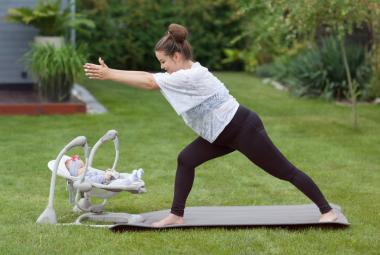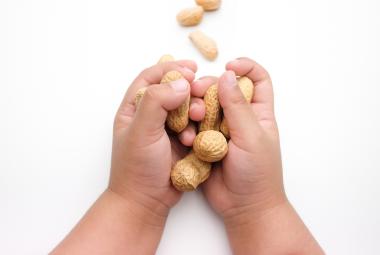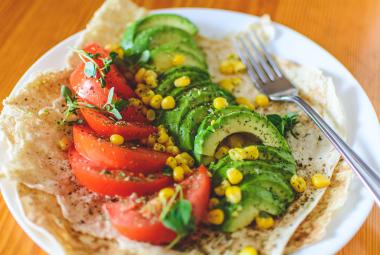It is recommended by the American Academy of Pediatrics that babies be breastfed exclusively until about 6 months. At 6 months, a baby’s needs, particularly for certain micronutrients, exceed what can be provided by breast milk alone. Thus, complementary solid foods should begin to “complement” a baby’s breast milk-based diet at that time.
When to begin solids
Signs that a baby is ready to begin trying foods include sitting up with minimal support, having good head control, intently watching others eat table food, and reaching for food. The loss of the tongue thrusting reflex, by which a baby immediately pushes food is out of its mouth, is also a good indicator of readiness for solid foods. Importantly, as foods are introduced, breast milk (or formula) should continue to be a major source of the baby’s nutrition until at least 12 months.
What foods to offer
There are many choices that are good for a baby’s first food, but a food that is high in iron should be one of the first foods. In the past, infant cereal was a popular choice (and often recommended) because it was believed it would be well liked and tolerated by the baby. Infant cereal is still an acceptable choice as long as it is fortified with iron. Meats are recommended as the first food in some countries because of their high content in, and babies’ high needs for iron. Soft, mashed vegetables are also an acceptable choice, but strained meats or iron-fortified cereals should be one of the first foods offered.
Single-ingredient foods should be offered first, waiting about 3 days before trying another new food. This allows you to monitor and observe for an intolerance or allergic reaction, such as rash, vomiting or diarrhea. By the time your baby is 7-8 months old, she should be consuming a variety of foods from all of the food groups. Offering variety is important for your baby to both develop a taste for a variety of nutritious foods, and for foods to provide a range of important nutrients. By around 9-12 months, your baby should be consuming combination foods similar to what the family eats, in textures that are appropriate and manageable.
Experts now recommend introducing common allergenic foods (peanuts, cow’s milk products, eggs, soy, wheat, tree nuts, shellfish, and fish) early on to decrease the chances of allergy development. This can be done once a child has already tolerated a few less allergenic complementary foods. An example of how to do this is mixing a small amount of peanut butter or peanut powder into a food that your baby already tolerates well. Once an allergenic food has been introduced, expose your baby to that food several times. If your baby has a history of eczema or food allergy, talk to your pediatrician. Note that liquid cow’s milk is not recommended for any child under 1 year of age because it is nutritionally inferior to breast milk or formula.
How to begin
When you start offering solid foods, make sure your baby is not too hungry. Give him a breast milk feeding (or formula feeding) just before the “meal” of solids. Babies, if they are too hungry, can get frustrated with the solid foods because they are not yet used to or skilled at eating new flavors or thicker textures. Be patient and encouraging as your baby develops these skills.
Start with small amounts. Begin offering a small amount (a “taste”) on a spoon at a time, with a total of only 1-2 teaspoons per “meal,” 1 or 2 times per day. Gradually increase the amount and number of times that solid foods are offered so that by 9 months your baby is consuming 2 or 3 nutritious meals. By 1 year, your baby should be consuming 3 meals with 1 or 2 snacks each day.
Watch your baby for cues of hunger and fullness. If your baby opens her mouth and is eager for food, she is likely still interested and/or hungry. If she turns her head away, keeps her lips closed, or spits the food out, those are signs that she is done eating or full. Respect and respond to your baby’s cues accordingly.
It is safe to start offering your baby sips of water in a cup once they start solids. Water should not replace breast milk or formula and should total a maximum of only 2-4 ounces per day. Some babies need water to prevent constipation after they start solid foods. Other babies do not need additional water until they start consuming less breast milk. Allow them to practice sips of water to develop skills with a cup.
Babies do not need juice, and they should not have juice if they are less than 12 months old. Juice has a potential to replace breast milk or formula, thereby reducing intake of protein, fat, vitamins and minerals. Offer whole fruit, mashed or pureed, instead.
Other tips
- Avoid adding sugar or salt to your babies’ foods.
- Always check the food temperature, especially when microwaving.
- Make sure your baby is sitting upright to eat, preferably in a high chair or other designated table. Your baby should never be reclined when eating solid foods.
- Establish a predictable schedule for meals and snacks.
- Encourage your baby’s involvement – put the spoon in her hand so she can bring it to her mouth, and offer soft “finger foods” (such as pieces of banana, baked sweet potato, well cooked noodles) once able to manage chunky textures.
- Avoid choking hazards, such as nuts, lumps of nut butters, popcorn, whole grapes, raw carrots, hot dogs, and hard candies.
- Minimize distractions (TV, videos, etc.) during meal and snack time.
- Avoid giving attention for not eating.
- Always stay with your baby when she is eating.
In recent years, a new strategy of introducing solid foods called “baby led weaning” or “baby led feeding” has gained interest. Using this strategy, pureed or mashed foods are skipped all together, and a baby begins eating whole, soft foods that the family eats. This method may be appropriate for some, but not all babies. Talk to your pediatrician if you plan to try this or have questions about whether this is appropriate for your baby.
If you have any concerns or questions about feeding your baby solids, talk to your pediatrician.
Christine D. Garner, PhD, RD







